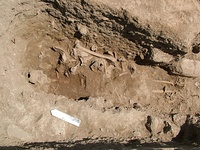| Collection: | Corinth | |
| Type: | Basket | |
| Name: | Temple E, Southeast, context 375 | |
| Area: | Temple E, Southeast | |
| Title: | Articulated skeleton in grave E of bench | |
| Category: | Deposit | |
| Notebook: | 1108 | |
| Context: | 375 | |
| Date: | 2014/05/25 | |
| Description: | Top slope of the context is slight down to the S. | |
| Notes: | This skull was uncovered on 20/5, and the feet on 12/5, as this burial was truncated by grave 2014-04 and its excavation revealed articulated feet assumed to belong to a/the inhumation in the grave (2014-07) to the N. This grave may be associated with bench-like structure 2014-302 on its west edge. This burial was fully exposed on 12/5 as first excavation of a secondary burial (Skeleton 2014-391, BL 2014-15) needed to occur to resolve whether it was piled next to or on top of the primary burial and which grave usage episode occurred first. Much hollow space is present around the bones of this burial, possibly the result of the bones or the tile which may have been laid over it, limiting sedimentary accumulation on the bones, or because of bioturbation. After finding the skull and exposing part of the feet, I then proceeded to trace the legs so tthat I could determine if the portion truncated by grave 2014-04 was the only portion of the body still articulated thanks to the presence of grave 2014-04's grave fill. After verifying that these bones do, indeed, extend past the line of the 188 grave cut, and that they are buried in a darker, softer matrix than that present in the majority of context 347, I finished exposing the secondary burial along the east wall of the finished grave cut. This is some debate whether this color change indicates a separate deposition of this secondary pile, or if it simply indicates the slow change of the matrix following decomposition of the primary interment. I am of the opinion, as the same matrix surrounded the secondary bone pile as the primary inhumation in grave 2014-04, that this would indicate contemporary deposition, while the difference in the matrix in this grave (2014-07) and its correspondence with the bottom of the bone pile and a number of broken tiles indicates that the deposition of the disarticulated remains was an event separate from the burial episode which resulted in the primary interment. However, these episodes do not appear to have been far separated in time, and with consultation with Jody, I have proceeded to take the overlying dirt of the primary interment in the same basket as that of the secondary interment. The secondary interment was removed first, at the end of session 2. The primary will be removed in session 3, and the pottery context (347) was left open. 2/6 : Excavation during session 3 exposed a number of skeletal elements that should be associated with the disarticulated bone pile on the west of the primary inhumation. These elements extend a bit under the bench structure, though not far, and were possibly not removed when the skeleton 375 was laid in the grave. The head of 375 was wedged into the NW-most corner of the grave cut and its head and shoulders elevated somewhat into the "luge" position. The arms were crossed over the abdomen, right over left, with the palms down. The mandible was not propped up on a tile, and so was discovered gaping open, resting on the vertebrae. The mandible is almost entirely edentelous. 3/6 : Lots of rain. Almost no progress for fear of mudding the enterprise. More secondary remains and the pelvis exposed, some of torso mapped. 4/6 : The torso through the pelvis was mapped and the remainder of the primary interment exposed and photographed. Another skull was also exposed to the W of the primary burial, and seems to belong to a separate grave cut which extends under where the bench (302) was. This grave cut seems to have been disturbed by the 317 grave cut, and to be earlier in date. 5/6 : The bones were lifted today and placed in trays according to anatomical identification. All bones except the pelvis and the spinal column were removed in fairly intact condition, but the axial skeleton was extremely crumbly. I attempted to use tin foil to stabilize the spine and to remove the pelvis as a block to minimize damage, but was not very successful. I assume that the rain a couple days ago did not help the situation with these spongy and flat bones, especially as the sediment surrounding them was still a little damp, htough not saturated, at the time of removal. Many teeth were found in and among the ribs, and a number of disarticulated subadult elements were scattered through the bones of the primary inhumation as well, so the grave fill had obviously not penetrated far past the tile layer separating the primary from the secondary inhumation. No obvious defects or pathologies, other than those attributable to age, were noted during the lifting of these bones, though the spine may exhibit slight kyphosis. After removal of the skull and cervical vertebrae, greenish clay roof tiles were noted which elevated the upper body into the luge position. | |
| Period: | Turkish I (1458-1680 AD) | |
| Grid: | 123.66-123.16E, 1071.99-1073.69N | |
| XMin: | 123.16 | |
| XMax: | 123.66 | |
| YMin: | 1071.99 | |
| YMax: | 1073.69 | |
| Site: | Corinth | |
| City: | Ancient Corinth | |
| Country: | Greece | |
| Masl: | 84.81-84.99m. | |
| References: | Image: digital 2014 0565 Image: digital 2014 0566 Image: digital 2014 0646 |
|
References Images (3) Classifications Sign in Provide feedback |
|


